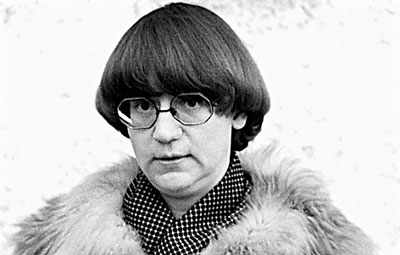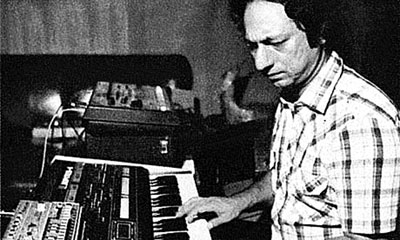|
|
| Events which didn’t happen Kaspars Groševs, Artist | |
| Ursula Bogner – Recordings 1969–1988 (Faitische, 2008) The story about the release of Ursula Bogner’s first recording begins with a flight to Vilnius, where Jan Jelinek got acquainted with a passenger sitting nearby, the German businessman Sebastian Bogner, and among other things found out, in the course of small talk, about his mother who, besides working as a pharmacist and being a conscientious housewife, was also into electronic music and “all sorts of synthesizers” in her spare time. The incidental conversation developed into subsequent correspondence, and Jelinek soon got hold of tapes of recordings carefully stored by Mrs Bogner. The tapes revealed original, even contemporary creative work which had never before been disclosed to the public. Jelinek selected 16 compositions which he considered to be the most interesting out of all works composed over a period of twenty years. The selection mostly consisted of short passages in which minimalist themes are outlined in concise manner. Bogner died in 1994, therefore most of her compositions have been preserved in unaltered form. This recording was the initial phase of activities of Jelinek’s record label Faitische, the name of which is a combination of the German word faktisch and French word fétiche, with emphasis on “element of fiction” associating both terms. Searches for interconnections between fact and fetish may seem redundant with respect to the release of recordings, yet one should remember that a recording isn’t a record, CD or MP3 file floating in infinity (albeit the existence of digital recordings occasionally resembles flashbacks of thoughts or a chasing after fortuities). Even if facts and fetishes appear quite momentarily, they form the necessary shapes and visions. A certain coherence may also be found in the quiet worship of analogous technologies, which increasingly noticeably flashes in the era of momentary solutions and “cyber-touch”, taking a stance of stubborn resistance. Whilst an authentic rendition embeds itself in the touching story of an average pharmacist, the sound becomes warmer and purer, allowing one to hear the smell of food, conversations and everyday worries present in the walls of a family home. | |
 Ursula Bogner | |
| This release is another fragment in the totality of the countless “forgotten pearls” washed up during the past decade, where dust and tarnish cover the waves of sound and the legends that accompany them. Mrs Bogner’s selection of magnetic tapes reveals a rich and even “fresh” sound, meanwhile retaining elements of roughness and genuineness. Whilst fitting in with the society of synthetic experimenters of the time, the recordings are a more naïve and an even clearer silent evidence of the quests of the era. The Czech artist Dominik Lang in his exhibition The Sleeping City at the Venice Biennale offered a similar description of his father’s sculptures, which had been created so long ago that they had become “sleeping witnesses”. The accompanying text by Jelinek provides a brief insight into the artist’s biography. Emphasis has been put on the “casual nature” of Bogner’s creative work – music as a hobby which is not destined to see daylight. Besides creating music, she was also painting, doing graphic art, and, owing to her keen interest in esoteric theories of psychoanalyst Wilhelm Reich on orgonomy and the curative properties of this kind of energy, she had also built an “orgone energy accumulator” in the yard of the family residence. From a contemporary point of view, Bogner’s compositions seem to complement experiments carried out by the Studio für elektronische Music of Cologne in the 1960s and 70s, which remained unnoticed at the time. However, the time of release couldn’t be more suitable, with the sweet scent of a rare discovery about it, and it is not confined by the indefinable burden of being a mission. One would prefer to compare it to an antique item which has never been used and has merely accumulated the pace of time and unclear speculations about its origins, therefore the suspicion that Ursula Bogner may be a product of Jelinek’s vivid imagination is not surprising at all. The question arises whether it is necessary to prove the genuineness of the authenticity of music, the value of which has largely been established here and now. It may not be that important after all whether Ursula Bogner has actually existed or not – in any case, she died more than 15 years ago. The recording is available for purchase at www.faitiche.de. Charanjit Singh – Synthesizing: Ten Ragas to a Disco Beat (Bombay Connection, 2010) Unlike the selection of Bogner’s works which had never been heard before, this recording has been released once – in India, in 1982. It didn’t gain popularity, though, and apparently drifted into oblivion for several decades. And, similarly to Bogner’s recordings, the authenticity of the works is often being questioned, attributing its actual origins to the famous master of disguise, Richard D. James, aka Aphex Twin. Charanjit Singh worked for the flourishing Bollywood industry in the early 1980s and simultaneously earned on the side by performing hits of the time with his orchestra at weddings. The work on Bollywood soundtracks was an opportunity to use many innovative devices of the time, including the Roland synthesizers TB-303 and TR-808 which are regarded as classic tools of electronic music nowadays, and initiated a musical revolution on the other side of the globe as early as the second half of the 1980s. | |
 Charanjit Singh | |
| Singh’s initial idea was quite simple, namely, to use the new technologies to revive the classic Indian ragas. These two matched quite well. A raga is formed of a simple musical motif which is repeated over and over again, and is complemented by layers of free improvisation. The bass synthesizer TB-303 enabled the programming of basic motifs of ragas which were then complemented by pure rhythms created by the drum machine TR-808 and accompanied by freely chosen synthetic variations. Thus the title of the recording is absolutely accurate – all ragas are almost identical in structure, whilst the only variables are the nature and introductory motifs of each particular composition. Singh took the liberty to experiment with synthesizers with respect to the variables. Owing to the “freshness” of the recording, the original version of it attracted the attention of internet hunters of rarities several years ago and overtook the work of pioneers of the acid house movement in America and England. The value of the recording formed much later, as the initial version remained covered with dust on the shelves of several hundred collectors and obviously didn’t initiate a revolution of techno music in India. Therefore one can only wonder at the indefinable recipe for a series of fortuities, coincidences and circumstances which turned an average Indian musician into one of the most surprising discoveries in music 28 years later. Even if another 28 years later he should turn out to be the product of somebody’s imagination. The recording is available for purchase at www.bombay-connection.com. /Translator into English: Jānis Aniņš/ | |
| go back | |







